Introduction
This tour ran from Monday 5th to Friday 9 September 2022, as part of the Australian flora conference (ANPSA). The weather gods were especially kind to our group during this time as it stayed completely fine for the full five days, even though it had rained constantly in the months before the tour and has continued to do so almost daily since!
It was a tour of wonderful contrasts – majestic mountains and expansive valleys; towering Eucalypts and exquisitely tiny orchids; ancient aboriginal culture and the pathways of European explorers; windswept sandstone rock formations and hanging swamps and damp fern lined tracks with waterfall views. A World Heritage area of amazing beauty and biodiversity and the remnants of an industrial past in coal mining and power generation. It was more than just a plant tour, it was the embodiment of the conference themes – Past, Present and Future.
What more can you expect when the tour was organised by Merle Thompson OAM with assistance in tour planning from Margaret Baker OAM, Jill Dark, Jim Ward and Heather and Phil Miles.
While the tour size was small with only six participants from Victoria (3), South Australia (2), and New Zealand (1) their combined botanical knowledge was vast. They were also a great group of people to share an amazing five days with and made my job as tour leader one of pure joy. Any gaps in my own Australian plant knowledge were more than made up as we were joined by Julie Favell, Chris Jonkers and Helen Drewe for Day 2 and Jim Ward for Days 3-5. Merle also joined us at various locations throughout the 5 days.
Day 1 – An introduction to the upper Blue Mountains: Mount Tomah, Mount Banks and Mount Wilson
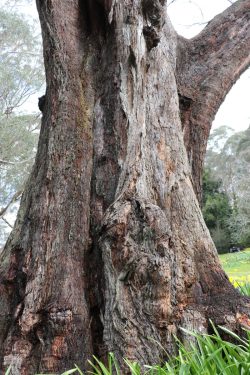
Journeying in the footsteps of Archibald Bell on the Bell’s Line of Road our participants started Day 1 of their tour in the lands of the Darug people at the Blue Mountains Botanic Garden.
Here we were treated to an informative and absorbing tour of the Gondwana and Australian woodland parts of the garden by the then Acting Curator of the Garden Ian Allen.
Ian was one of the people helicoptered in to save the original population of the Wollemi pines during the Black Summer bushfires and his recount of those eventful days showed us how close we were to loosing these unique trees, and what the dedication of a small team of highly trained and resourceful individuals can achieve.
I have personally visited the Gardens at Mount Tomah many times, however this visit for me was all about the trees, especially the mighty Eucalyptus fastigata, a locally abundant species (including where I live in Hampton) growing in cold wet areas on fertile soils, which can reach up to 50m high.
The ones in the Gardens and at Mount Wilson must be close to that height and likely to be hundreds of years old.
We next travelled to Mount Banks where despite the spectacular escarpment views on offer some serious botanizing commenced as we rambled through the Blue Mountains sandstone plateau flora.
Despite being early spring there was much in flower both along the track up to the mountain and at our second stop amongst the exposed heath including Actinotus helianthi, Boronia ledifolia, Epacris obtusifolia, Hibbertia pustulata (a Blue Mountains endemic), Philotheca obovalis (another Blue Mountains endemic), Zieria laevigata and some tiny Sowerbaea juncea to name just a few.
A quick bus tour of the Mount Wilson area followed, where we passed many large homes set amongst English-style cool climate gardens, multiple pockets of lush Dicksonia antarctica tree ferns and towering Eucalypts still showing the impacts of the 2019/20 bushfires.
Day one then concluded out of the mountains in the Central West town of Wallerawang home to a historic church designed by Edmund Blackett and the remnants of the Wallerawang power station, which is being transformed into a renewable energy precinct and our home for the next two nights.

Day 2: Long Swamp, Maiyingu Marragu, Gardens of Stone State Conservation Area, and Hassan’s Walls.
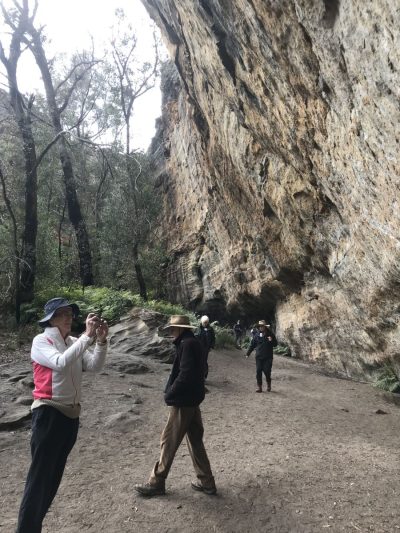
Our first stop of Day 2 was at Long Swamp, an example of a montane swamp, a threatened ecological community of dense sedgelands and grasslands and sclerophyllous shrubs. Here we were joined by our guides for the day Julie Favell and Chris Jonkers. Julie and Chris are key members of the Lithgow Environment Group which is dedicated to preserving the balance of nature in the Lithgow region. The Lithgow Environment Group in partnership with Wilderness Australia (formerly the Colong Foundation for Wilderness, the Blue Mountains Conservation Society, the Nature Conservation Council and the National Parks Association were instrumental in campaigning to have the pagoda landscape, cliffs, waterfalls, woodlands and swamps of the Newnes, Ben Bullen and Wolgan State Forests and Crown Reserve Land near Mount Piper recently included within the 28,322-hectare Gardens of Stone State Conservation Area, forming a link between the Wollemi, Blue Mountains, and Gardens of Stone national parks.
The cool wet spring meant that flowering had been delayed so Julie and Chris were able to show us a good range of species.
A short bus ride then brought us to the Maiyingu Marragu Aboriginal Reserve in Wiradjuri country. The site includes significant rock shelters, 13,000-year-old handprint and other rock art images, small fern-lined waterfalls and both a men’s and women’s area. The site is still used by the local Mingaan people (part of the Wiradjuri Nation) for story telling and teaching about bush foods and medicines.
Though there were many interesting plants along the trail to the rock shelter, it was the rock formations and rock art works that captured much of our attention. The place had a definite presence, and it was easy to understand why the Mingaan and other Wiradjuri people considered it such a special place to meet, tell stories and learn.
We then travelled to the Wolgan Lookout to take in the panoramic Wolgan Valley before heading to the pagoda landscape of Dobbs Drift, the stepping off point for the newly designated Gardens of Stone Conservation Area.
Both Merle and Helen Drewe joined Julie and Chris and the group for yet another amazing plant ramble amongst the pagoda formations where we spotted white tinged pink Boronia rigens, the deep pink hanging bells of Epacris reclinata and Leionema lamprophyllum subsp. orbiculare with its red buds that open into dainty cream-coloured star shaped flowers. Chris also showed us some Dianella tenuissima growing in a rock crevice which was only described in 2006.
Following lunch in Blast Furnace Park, which showcases the remnants of Lithgow’s steel making industry we then spent the afternoon at Hassan’s Walls Reserve. The Reserve is located at the transition point between the flora of the Sydney Basin Bioregion and the Central Tablelands and contains several different plant communities including exposed dry heath, open forest, woodland, and taller moist forests of shaded gullies.
The altitude of the Reserve varies between 960-1160 metres thus providing us with expansive views of the Blue Mountains escarpment and the adjacent ranges and valleys. Walking around the lookout boardwalk area and along just one of the many fire trails in the Reserve did not disappoint as we saw (possibly?) two different species of Pterostylis orchids, Hakea pachyphylla (a Blue Mountains endemic), Boronia microphylla, Phebalium squamulosum subsp. ozothamnoides and the golden candles of Banksia marginata.
Chris and Don wrote: “It is wonderful that such a beautiful and relatively untouched area can still be found in an area so close to the town of Lithgow making it easily accessible. I hope the town of Lithgow encourages its protection into the future.”
Day 3 – Mount York and Blackheath
Our start off point on Day 3 was the historically significant area of Mount York, as it was here that the first Europeans tackled the descent from the Blue Mountains to the Hartley Valley below, allowing the settlement to expand westward to Bathurst and the western plains beyond.
Here we were expertly guided by keen bushwalker and long-time Blue Mountains Group member Jim Ward, who was easy to spot in his eccentric white and red hat, as we followed the walking track down to the remnants of William Cox’s Road.
Built in 1814/15 with a 1:4 steep grade it appeared to just plummet vertically into the valley below!
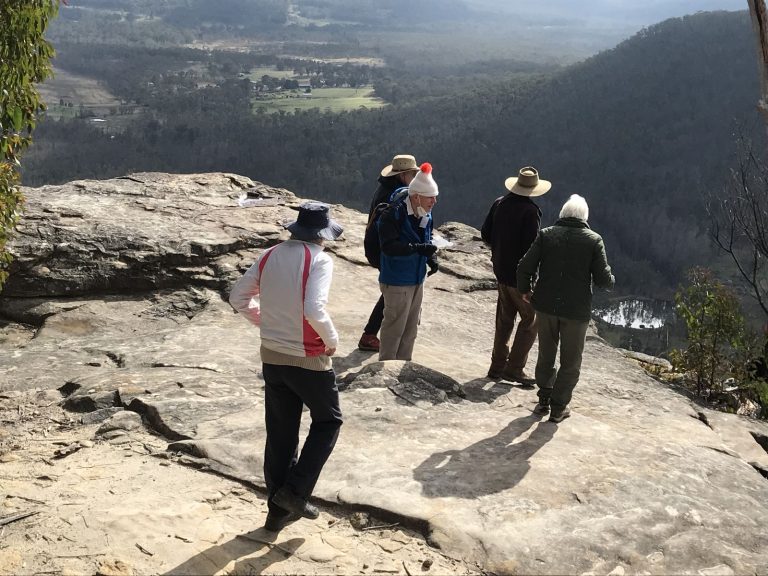
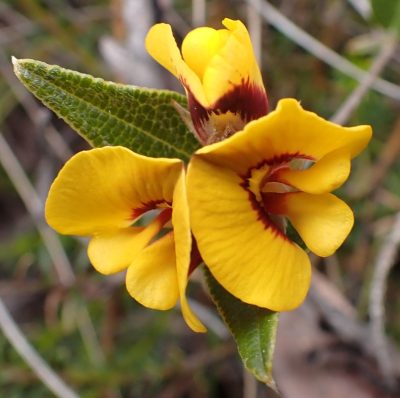
Either side of the track showed clear evidence of bushfire damage but was now thickly revegetated with various Eucalypt species, Hardenbergia violacea, Lomandra obliqua, Persoonia linearis, Pimelea linifolia, Acacia ulicifolia and Leucopogon lanceolatus.
We then journeyed onto Blackheath where we wandered the Fairfax Heritage Track spotting Persoonia chamaepitys, Petrophile pulchella, Hakea sericea and in bud Telopea speciosissima followed by yet more expansive views of the Blue Mountains World Heritage Area.
Our day concluded with a winding botanizing ramble along a section of the Burramoko (Hanging Rock) Trail looking at heathland, forest and swamp floral communities and finding Comesperma ericinum, Hakea dactyloides, Goodenia bellidifolia, Mirbelia platyloboides and many pockets of Lycopodium deuterodensum or Bushy Clubmoss.
Blackheath then became our home for the next 2 nights.
Day 4 – Wentworth Falls and Kings Tablelands
Day 4 found us doing the Overcliff-Undercliff track at Wentworth Falls. This track combined clifftop, waterfall and Jamison Valley views, many steps, and the joy of walking under massive rock overhangs.
Each overhang appearing to have its own unique grouping of plants. Two special plants seen were Xanthosia scopulicola and Sprengelia monticola, both Blue Mountain endemic species.
The track took us through swamp, heath, and rainforest where we were frequently serenaded by scrub wrens and black and white cockatoos. Even the road to and from the car park contained wonderful banks spotted with Pterostylis parviflora and P. penduculata orchids.
Following morning tea, we journeyed onto Katoomba where we played tourist viewing the Cascades, Echo Point, the Three Sisters, and Boars Head Lookout.
We then travelled further down the mountains to Kings Tablelands, one of the largest heath areas in the Blue Mountains.
Here we wandered among windswept rock platforms and through low shrubbery including stunted mallees, and low growing Banksias, Hakeas and Isopogons.
Once again, the car park contained some treats for us including Actinotus minor with its tiny 10mm diameter flowerheads and Patersonia longifolia.
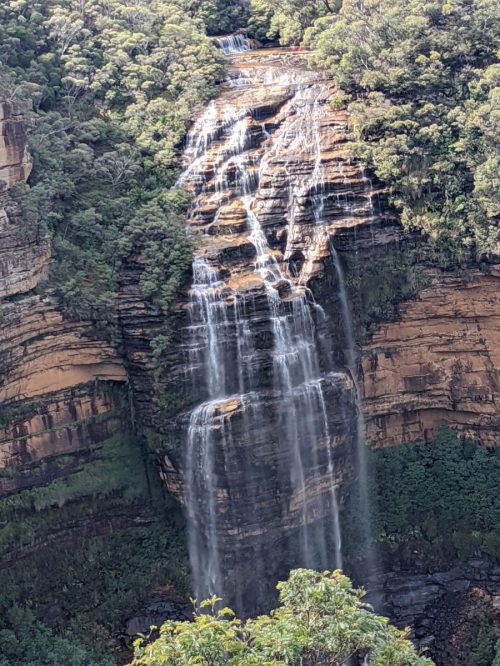
Day 5 – Woodford and Glenbrook Reserve
Our final day commenced in Woodford where we ended up rambling along a broad fire trail and into orchid heaven with Caleana major (Flying Duck), Caladenia carnea (Pink Fingers) and numerous Thelymitra species appearing everywhere.
Glenbrook Native Plant Reserve where the Blue Mountains Group meets and runs a nursery was our last stop on the tour. Here Jim led us on a comprehensive tour of the Reserve and where the group finally saw its first waratah in full flower. A lovely note on which to finish our tour of truly diverse and unique ecosystems.
Words and some images by Lynne Bruce with additional comments and images from tour members. Report compiled by Lynne Bruce and Merle Thompso
